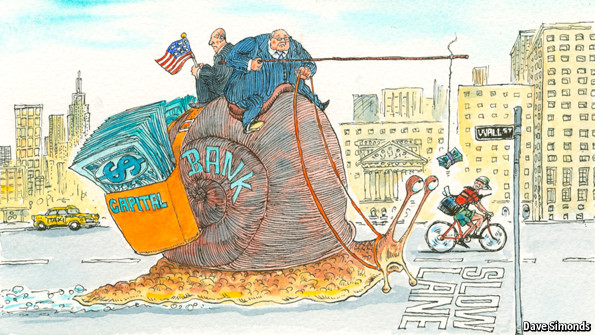by Economist

“IT COULD have been worse” was the common refrain as American banks began reporting their second-quarter earnings. Indeed, the striking characteristic of the returns was their consistency. Big and small, local and national, lenders across the country have been benefiting from some common tailwinds. Legal settlements are becoming sparser; the economy is expanding, albeit feebly, and the housing market is recovering; auditors are pushing banks to keep releasing loan-loss reserves; and actual losses are trivial.
But avoiding disaster is not really cause for celebration. Consumers continue to shed debt; companies carry ever more cash. Banks’ pre-provision revenue growth is muted (see chart 1), and there has been no recovery in loan growth of the sort seen after previous recessions (see chart 2). This is so unusual that it may be unprecedented, says Michael Mayo, an analyst at CSLA, a securities firm, and it hardly suggests a good prognosis for the banking system. He predicts that the current decade will show the worst revenue growth for banks since the 1930s. Pricing and margins will inevitably tighten as a result.

In as much as borrowing activity has shifted from banks’ balance-sheets to the capital markets, some have benefited. The investment-banking arm of perpetually troubled Citigroup did well in the second quarter, as did the investment-banking arm of infrequently troubled Goldman Sachs. Underwriting and advisory revenues rose at both firms. Goldman reaped large gains from its own investments.
But Goldman’s return on equity was still barely in double digits. Its headcount is shrinking, not expanding. That is typically the single best indicator of an investment firm’s perspective on its prospects. Citi’s return on equity was well below Goldman’s, at 6.5%. Investors will not tolerate that sort of performance for ever. A major source of Citi’s revenue is in emerging markets, where conditions are deteriorating.
The likelihood that the overall banking environment will improve in the near future is low. Recent rises in interest rates, prompted by expectations that the Federal Reserve will start slowing the pace of asset purchases, will take a toll on mortgage refinancing, a source of revenue that has produced great gobs of money for banks in recent years. It is probably no coincidence that share prices for most financial institutions have flattened in recent weeks.

Regulators and politicians are still trying to suppress banks’ risk appetite, not whet it. American financial institutions are already expecting to hold more risk-weighted capital in order to conform with the international Basel 3 standards. Worried by the potential for banks to game the calculations that underpin these same risk weightings, regulators this month proposed a higher “leverage ratio”, a blunter measure of capital that reflects the overall size of a bank’s balance-sheet as well as its riskiness. The proposal calls for a 5% leverage ratio at the holding-company level, and 6% at the level of the bank, for the eight largest banks: Bank of America, BNY Mellon, Citigroup, Goldman Sachs, JPMorgan Chase, Morgan Stanley, State Street and Wells Fargo.
The new numbers will require institutions to fund themselves with more equity, further diluting returns (at least in the short term). Although the notion of a strict capital ratio has its detractors, it has a good chance of being instituted, says Michael Poulos of Oliver Wyman, a consultancy, if only because it is simple. But by increasing the cost of funding for the big institutions, he warns, the rule may push them away from safer, low-priced products and towards riskier, higher-margin ones.
Bankers have not reacted vocally to the leverage-ratio proposal. That may be because they feared even harsher limits, or because they are keeping their powder dry for other fights. Lawmakers continue to circle the industry. In April two senators, Sherrod Brown and David Vitter, introduced a bill that would require the largest banks to increase their equity capital to 15% of assets. It was loudly applauded, and subsequently quietly ignored. On July 11th four senators proposed bringing back a version of the Glass-Steagall Banking Act of 1933 that separated commercial banking from investment banking. This idea has also garnered lots of praise and is also likely to be ignored, if only because of the practical difficulties involved.
Even if these legislative proposals go nowhere, the regulatory environment is poised to become tougher with the Senate’s approval on July 16th of Tom Perez as secretary of labour and Richard Cordray as head of the Consumer Financial Protection Bureau (CFPB). In his prior position at the Department of Justice Mr Perez was an influential advocate of the principle of “disparate impact”—the idea that lending policies can be discriminatory because of their outcomes, even if there is no intent to discriminate. His approval is a congressional endorsement of uneconomic lending.
Mr Cordray’s appointment unlocks broad powers for the newly established CFPB, including the ability to investigate and regulate the price and scope of financial products under a new and undefined “abusive” standard. Senate Republicans had vowed to refrain from approving Mr Cordray until changes were made to the CFPB’s underlying structure, so that less power was concentrated in a single director and its budget was made subject to congressional approval. Whatever concerns they had were abruptly waived. Perhaps, like many of America’s banks, they concluded that however bad things are, they could always be worse.
No comments:
Post a Comment